Exhibit 99.2
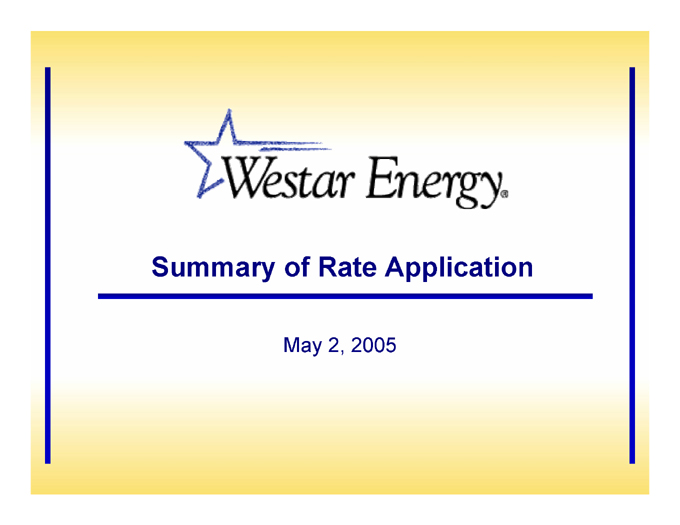
Summary of Rate Application
May 2, 2005
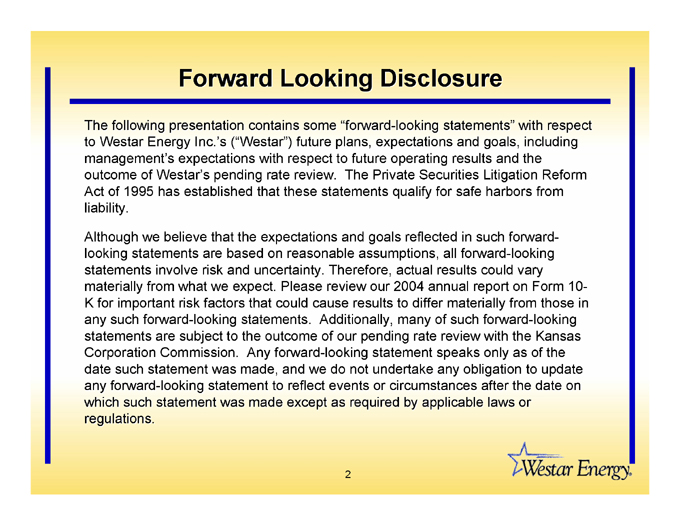
Forward Looking Disclosure
The following presentation contains some “forward-looking statements” with respect to Westar Energy Inc.’s (“Westar”) future plans, expectations and goals, including management’s expectations with respect to future operating results and the outcome of Westar’s pending rate review. The Private Securities Litigation Reform Act of 1995 has established that these statements qualify for safe harbors from liability.
Although we believe that the expectations and goals reflected in such forward-looking statements are based on reasonable assumptions, all forward-looking statements involve risk and uncertainty. Therefore, actual results could vary materially from what we expect. Please review our 2004 annual report on Form 10-K for important risk factors that could cause results to differ materially from those in any such forward-looking statements. Additionally, many of such forward-looking statements are subject to the outcome of our pending rate review with the Kansas Corporation Commission. Any forward-looking statement speaks only as of the date such statement was made, and we do not undertake any obligation to update any forward-looking statement to reflect events or circumstances after the date on which such statement was made except as required by applicable laws or regulations.
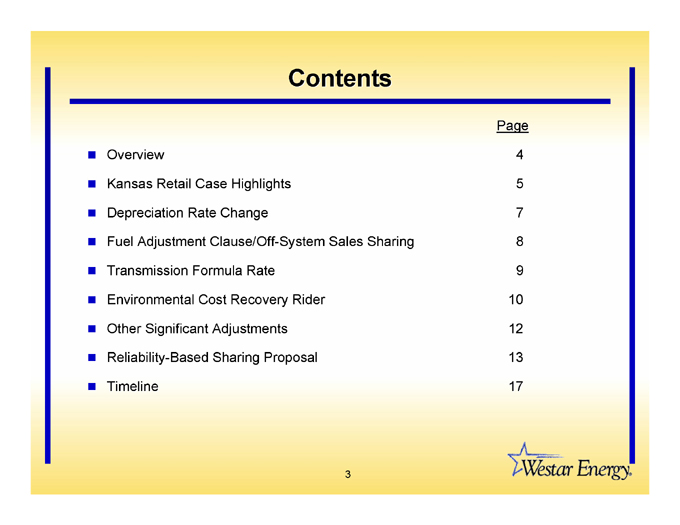
Contents
Page
Overview 4
Kansas Retail Case Highlights 5
Depreciation Rate Change 7
Fuel Adjustment Clause/Off-System Sales Sharing 8
Transmission Formula Rate 9
Environmental Cost Recovery Rider 10
Other Significant Adjustments 12
Reliability-Based Sharing Proposal 13
Timeline 17
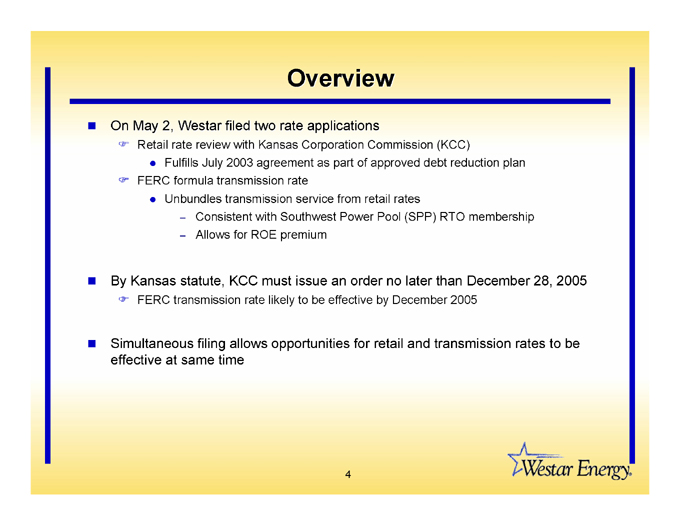
Overview
On May 2, Westar filed two rate applications
Retail rate review with Kansas Corporation Commission (KCC)
Fulfills July 2003 agreement as part of approved debt reduction plan
FERC formula transmission rate
Unbundles transmission service from retail rates
Consistent with Southwest Power Pool (SPP) RTO membership
Allows for ROE premium
By Kansas statute, KCC must issue an order no later than December 28, 2005
FERC transmission rate likely to be effective by December 2005
Simultaneous filing allows opportunities for retail and transmission rates to be effective at same time
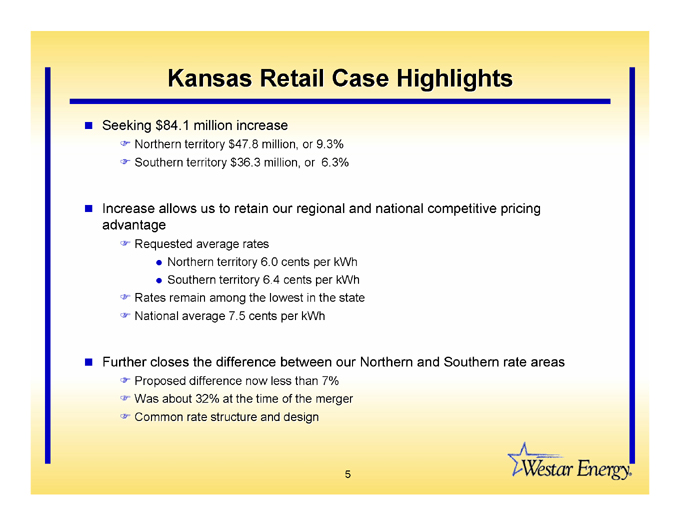
Kansas Retail Case Highlights
Seeking $84.1 million increase
Northern territory $47.8 million, or 9.3%
Southern territory $36.3 million, or 6.3%
Increase allows us to retain our regional and national competitive pricing advantage
Requested average rates
Northern territory 6.0 cents per kWh
Southern territory 6.4 cents per kWh
Rates remain among the lowest in the state
National average 7.5 cents per kWh
Further closes the difference between our Northern and Southern rate areas
Proposed difference now less than 7%
Was about 32% at the time of the merger
Common rate structure and design
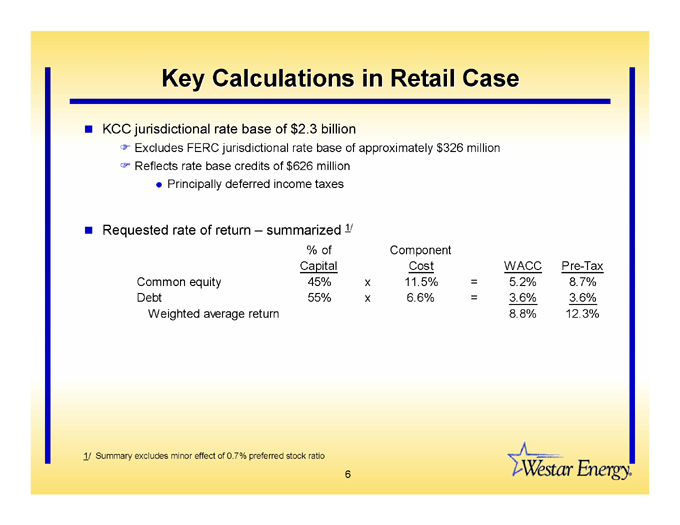
Key Calculations in Retail Case
KCC jurisdictional rate base of $2.3 billion
Excludes FERC jurisdictional rate base of approximately $326 million
Reflects rate base credits of $626 million
Principally deferred income taxes
Requested rate of return – summarized 1/
| | | | | | | | | | | | |
| | | % of
Capital | | | Component
Cost | | | WACC | | | Pre-Tax | |
Common equity | | 45 | % | | x
11.5
= |
%
| | 5.2 | % | | 8.7 | % |
Debt | | 55 | % | | x
6.6
= |
%
| | 3.6 | % | | 3.6 | % |
Weighted average return | | | | | | | | 8.8 | % | | 12.3 | % |
1/ Summary excludes minor effect of 0.7% preferred stock ratio
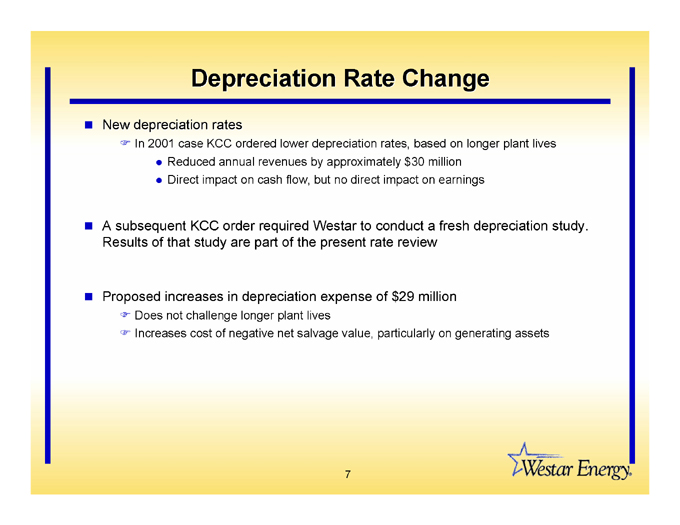
Depreciation Rate Change
New depreciation rates
In 2001 case KCC ordered lower depreciation rates, based on longer plant lives
Reduced annual revenues by approximately $30 million
Direct impact on cash flow, but no direct impact on earnings
A subsequent KCC order required Westar to conduct a fresh depreciation study. Results of that study are part of the present rate review
Proposed increases in depreciation expense of $29 million
Does not challenge longer plant lives
Increases cost of negative net salvage value, particularly on generating assets
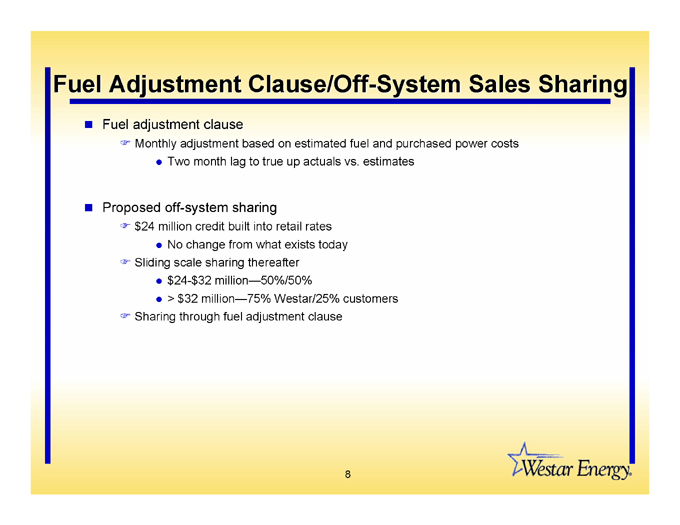
Fuel Adjustment Clause/Off-System Sales Sharing
Fuel adjustment clause
Monthly adjustment based on estimated fuel and purchased power costs
Two month lag to true up actuals vs. estimates
Proposed off-system sharing
$24 million credit built into retail rates
No change from what exists today
Sliding scale sharing thereafter
$24-$32 million—50%/50%
$>32 million—75% Westar/25% customers
Sharing through fuel adjustment clause
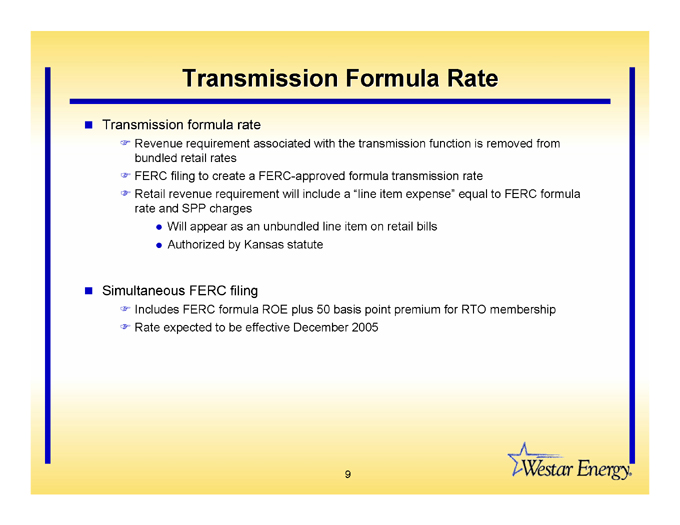
Transmission Formula Rate
Transmission formula rate
Revenue requirement associated with the transmission function is removed from bundled retail rates
FERC filing to create a FERC-approved formula transmission rate
Retail revenue requirement will include a “line item expense” equal to FERC formula rate and SPP charges
Will appear as an unbundled line item on retail bills
Authorized by Kansas statute
Simultaneous FERC filing
Includes FERC formula ROE plus 50 basis point premium for RTO membership
Rate expected to be effective December 2005
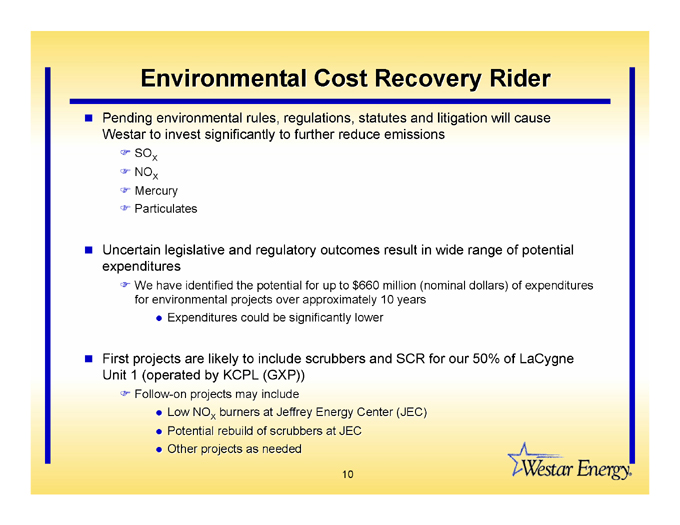
Environmental Cost Recovery Rider
Pending environmental rules, regulations, statutes and litigation will cause Westar to invest significantly to further reduce emissions
SOX
NOX
Mercury
Particulates
Uncertain legislative and regulatory outcomes result in wide range of potential expenditures
We have identified the potential for up to $660 million (nominal dollars) of expenditures for environmental projects over approximately 10 years
Expenditures could be significantly lower
First projects are likely to include scrubbers and SCR for our 50% of LaCygne Unit 1 (operated by KCPL (GXP))
Follow-on projects may include
Low NOX burners at Jeffrey Energy Center (JEC)
Potential rebuild of scrubbers at JEC
Other projects as needed
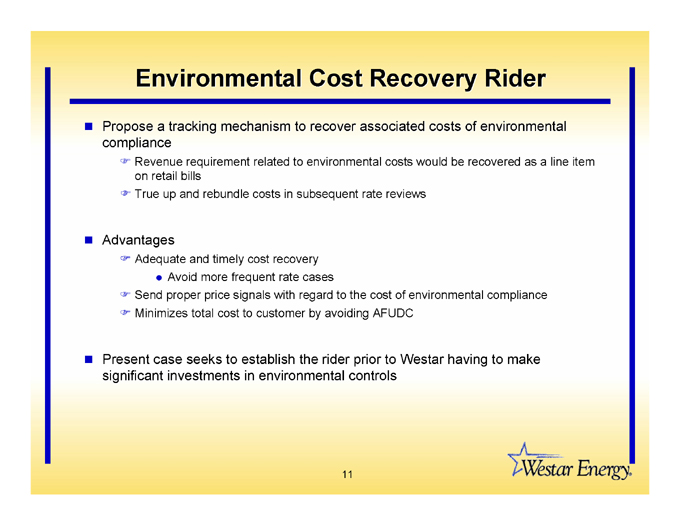
Environmental Cost Recovery Rider
Propose a tracking mechanism to recover associated costs of environmental compliance
Revenue requirement related to environmental costs would be recovered as a line item on retail bills
True up and rebundle costs in subsequent rate reviews
Advantages
Adequate and timely cost recovery
Avoid more frequent rate cases
Send proper price signals with regard to the cost of environmental compliance
Minimizes total cost to customer by avoiding AFUDC
Present case seeks to establish the rider prior to Westar having to make significant investments in environmental controls
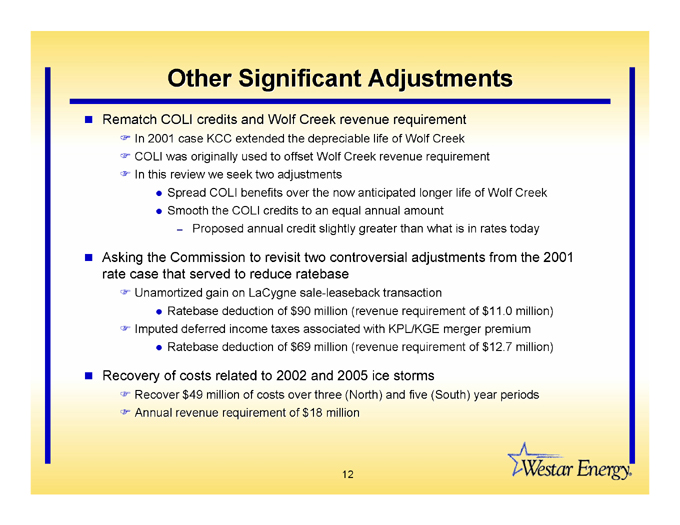
Other Significant Adjustments
Rematch COLI credits and Wolf Creek revenue requirement
In 2001 case KCC extended the depreciable life of Wolf Creek
COLI was originally used to offset Wolf Creek revenue requirement
In this review we seek two adjustments
Spread COLI benefits over the now anticipated longer life of Wolf Creek
Smooth the COLI credits to an equal annual amount – Proposed annual credit slightly greater than what is in rates today
Asking the Commission to revisit two controversial adjustments from the 2001 rate case that served to reduce ratebase
Unamortized gain on LaCygne sale-leaseback transaction
Ratebase deduction of $90 million (revenue requirement of $11.0 million)
Imputed deferred income taxes associated with KPL/KGE merger premium
Ratebase deduction of $69 million (revenue requirement of $12.7 million)
Recovery of costs related to 2002 and 2005 ice storms
Recover $49 million of costs over three (North) and five (South) year periods
Annual revenue requirement of $18 million
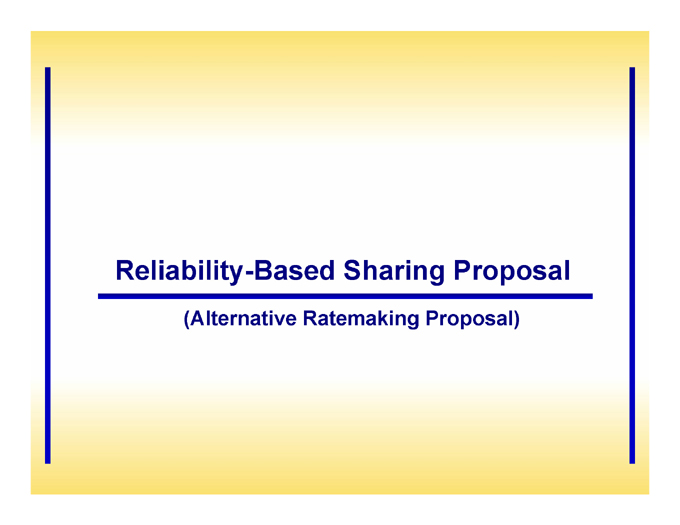
Reliability-Based Sharing Proposal
(Alternative Ratemaking Proposal)
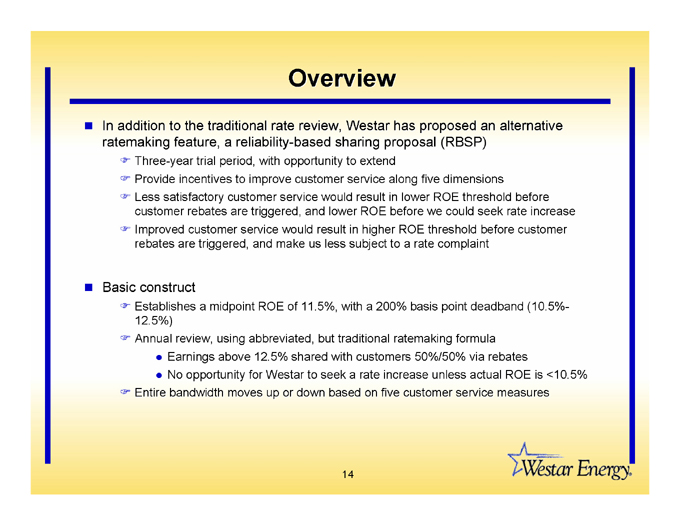
Overview
In addition to the traditional rate review, Westar has proposed an alternative ratemaking feature, a reliability-based sharing proposal (RBSP)
Three-year trial period, with opportunity to extend
Provide incentives to improve customer service along five dimensions
Less satisfactory customer service would result in lower ROE threshold before customer rebates are triggered, and lower ROE before we could seek rate increase
Improved customer service would result in higher ROE threshold before customer rebates are triggered, and make us less subject to a rate complaint
Basic construct
Establishes a midpoint ROE of 11.5%, with a 200% basis point deadband (10.5%-12.5%)
Annual review, using abbreviated, but traditional ratemaking formula
Earnings above 12.5% shared with customers 50%/50% via rebates
No opportunity for Westar to seek a rate increase unless actual ROE is <10.5%
Entire bandwidth moves up or down based on five customer service measures
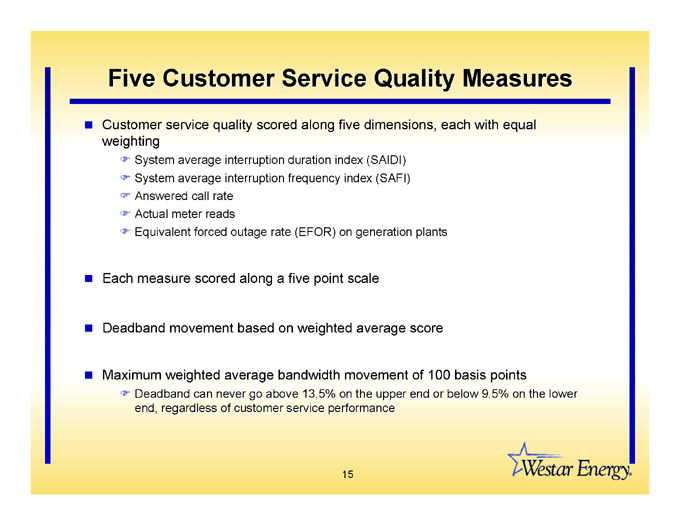
Five Customer Service Quality Measures
Customer service quality scored along five dimensions, each with equal weighting
System average interruption duration index (SAIDI)
System average interruption frequency index (SAFI)
Answered call rate
Actual meter reads
Equivalent forced outage rate (EFOR) on generation plants
Each measure scored along a five point scale
Deadband movement based on weighted average score
Maximum weighted average bandwidth movement of 100 basis points
Deadband can never go above 13.5% on the upper end or below 9.5% on the lower end, regardless of customer service performance
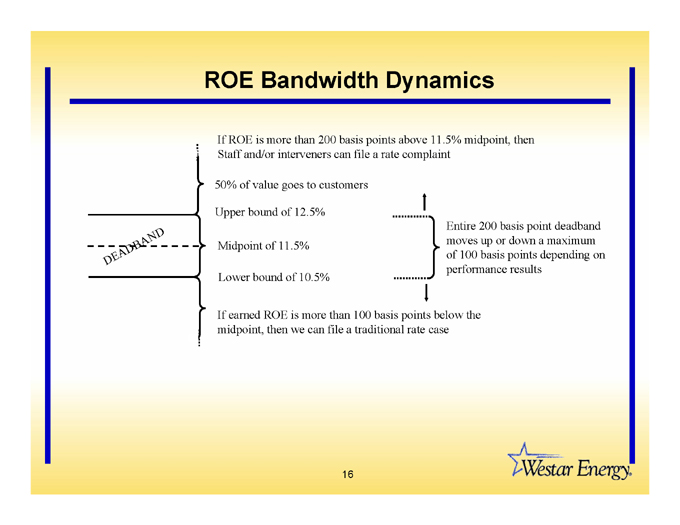
ROE Bandwidth Dynamics
If ROE is more than 200 basis points above 11.5% midpoint, then Staff and/or interveners can file a rate complaint
50% of value goes to customers
Upper bound of 12.5%
Midpoint of 11.5%
Lower bound of 10.5%
If earned ROE is more than 100 basis points below the midpoint, then we can file a traditional rate case
Entire 200 basis point deadband moves up or down a maximum of 100 basis points depending on performance results
DEADBAND
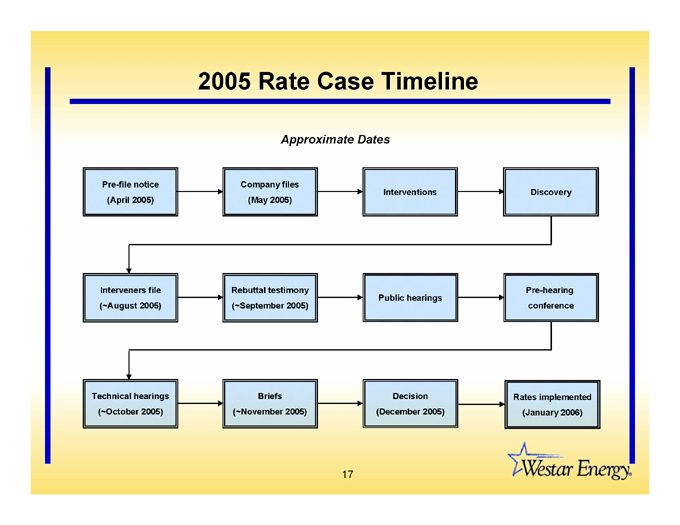
2005 Rate Case Timeline
Approximate Dates
Pre-file notice
(April 2005)
Company files
(May 2005)
Interventions
Discovery
Interveners file
(~August 2005)
Rebuttal testimony
(~September 2005)
Public hearings
Pre-hearing
Conference
Technical hearings
(~October 2005)
Briefs
(~November 2005)
Decision
(December 2005)
Rates implemented
(January 2006)
















